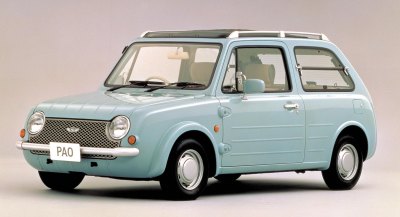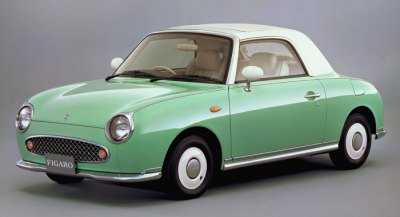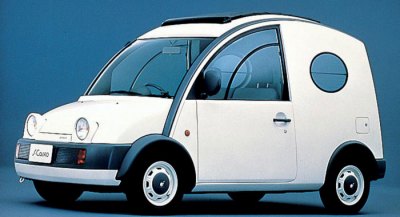Characterized by a pair of round eyes, the Be-1 was clearly inspired by the classic Mini Cooper but it looked simultaneously modern and functional. Its interior featured a big white-faced dial floating above the dashboard, circular air vents and color-coded door panels, i.e. things that you can find in the later New Beetle, Mini and Fiat 500. How can you not admire the creativity of Mr. Sakai? Now who say the copycat must be Japanese? Thanks to its funky styling, the Be-1 was a hit, with demand outstripping supply by far so that it took a lucky draw to decide buyers. People loved its style so much that they could easily forgive its lack of performance – the March's 1.0-liter 8-valve engine produced only 52 horsepower and propelled the car to no more than 87 mph. Admittedly, used as a city car in Japan it didn't need a lot of power.
Because of its success, Nissan worked with Naoki Sakai again
to create 2 more specials, Pao (1989) and Figaro (1991). The Pao was a
modern interpretation of Renault 4 (with some elements from Citroen
2CV) and based on the same underpinnings of Be-1. The Figaro was a
retro convertible and perhaps the most elegant of all. It ran the
turbocharged version of the 1-liter engine with 76 hp. Their production
were outsourced to Aichi Machine and Takada Kogyo, respectively. Over
51,000 Paos and exactly 20,000 Figaros were built.
Another car born out of the same engineering team, if not penned by Naoki Sakai, was S-Cargo. This was a really funky, cartoonish small cargo van characterized by its arc shape and dramatic tallness. It was again derived from March but power came from Pulsar's 1.5-liter engine with 73 hp. I have seen this car many times on the streets of Hong Kong. Many used it as a mobile advertisement to promote business. One restaurant in Sai Kung even owned two, a luxury considering only 10,600 cars were made. |



